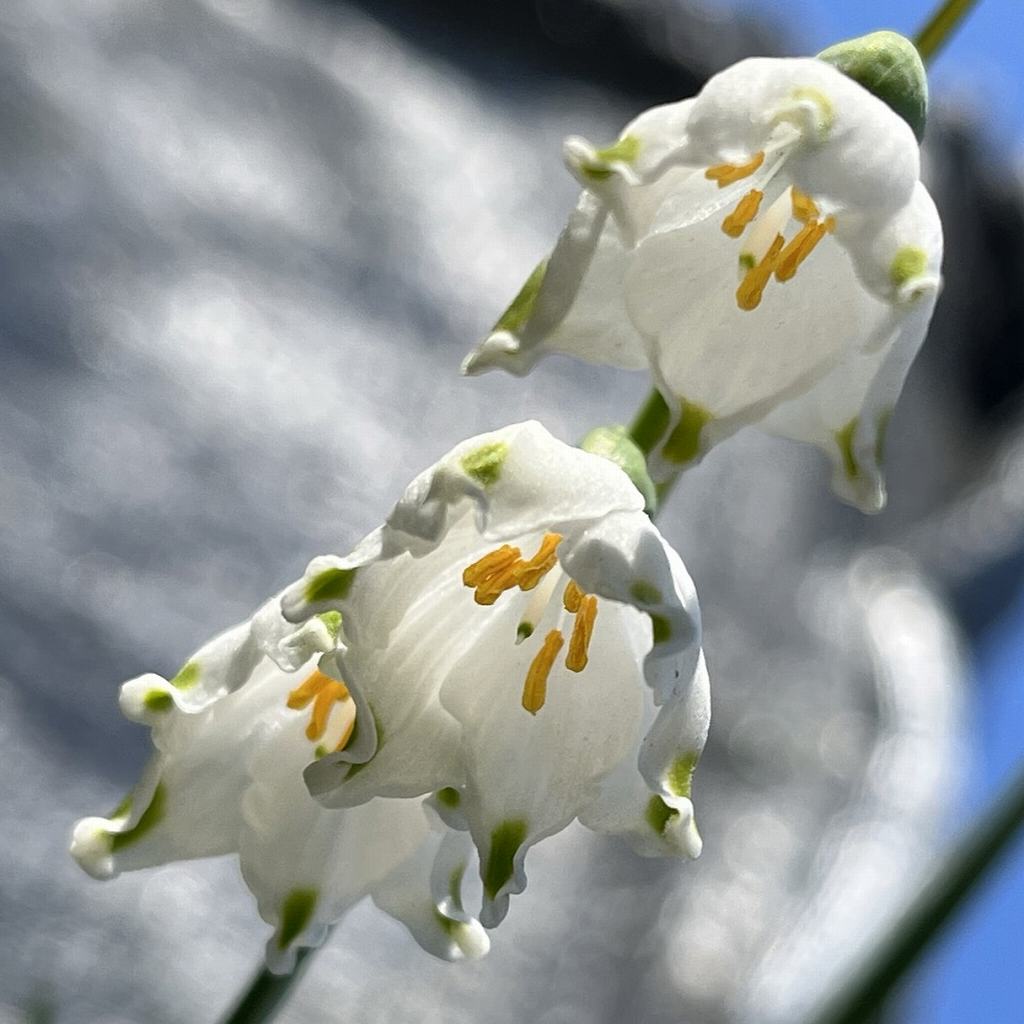スノーフレークは「雪片」を意味する英名で、白色の可憐な花々に由来。葉が水仙、花が鈴蘭に似ています。花言葉は「純粋」「純潔」など。
The name of Snowflake comes from pretty white flowers. The leaves resemble Narcissus and the flowers resemble Lily of the Valley. The language of flowers is “pure” and “purity” etc.
【仮名】スノーフレーク, オオマツユキソウ, スズランズイセン
【和名】大待雪草, 鈴蘭水仙
【英名】Snowflake, Loddon Lily
【学名】Leucojum aestivum
【誕生】01/ 28, 02/ 23, 04/ 16, 12/ 19
【開花】03, 04月
【花色】White
スノーフレーク
スノーフレークの概要

スノーフレークはヒガンバナ科の多年草です。原産地はオーストリア、ハンガリーなどの欧州中南部で、日本へは昭和時代の初期に渡来。春に地中の球根から葉や茎を伸ばし、白色の可憐な花々を咲かせます。夏には茎や葉が枯れ、秋~冬に休眠。花言葉は「純粋」「純潔」などです。
スノーフレークの名前

スノーフレークは「雪片」を意味する英名で、白色の花々に由来します。この言葉は人柄の形容にも用いられ、「個性的」や「傷つきやすい」という意味。ラテン語の属名レウコユムは「白色の菫」という意味で、花の香りに由来します。種小名アエスティウムは「夏の」という意味。
スノーフレークの姿形

スノーフレークは「鈴蘭水仙」とも呼ばれます。葉は「水仙」に似て、細長い線形で根生。花茎は薄い管状で細長く立ち上がります。花は「鈴蘭」に似て、白色の釣鐘型。花冠の先端に緑色の斑が入ります。花被片が6枚、雄しべが6本。花後の蒴果は熟すと黒色の種子を散らします。
スノーフレークの類縁

スノーフレークは「大待雪草」とも呼ばれます。これは類縁の「スノードロップ」に姿形が似ながら、草丈が大きいから。「待雪草」はスノードロップの和名です。どちらもヒガンバナ科ですが、スノーフレークは茎の先端に複数の花を咲かせるのに対し、スノードロップは1輪だけ。
スノーフレークの利用

スノーフレークは「夏雪片蓮」という生薬で、中国では昔、鱗茎が化膿した出来物、腫れ物、咳などに用いられました。しかし、実際には毒性のあるアルカロイド「ガランタミン」を多く含有。誤食により悪心、嘔吐、下痢などの食中毒症状を起こす恐れがあり、薬用には向きません。
Snowflake
Snowflake is a perennial plant of Amaryllidaceae. It originated in central and southern Europe such as Austria and Hungary, and was introduced to Japan in the early Showa period. In spring, the leaves and stems are extended from underground bulbs, and pretty white flowers bloom. Stems and leaves wither in summer and go dormant in autumn and winter. The language of flowers is “pure” and “purity”.
The name of Snowflake comes from pretty white flowers. This word is also used to describe personality, meaning “unique” or “vulnerable”. The Latin genus name Leucojum means “white violet” and is derived from the scent of the flowers. The species name Aestivum means “summer”.
Snowflake has a Japanese name that means “Narcissus like Lily of the Valley”. The leaves are long, linear and basal, similar to Narcissus. The flower stalk is thin, tubular and elongated. The flowers are white and bell-shaped, similar to “Lily of the Valley”. There is a green spot at the tip of the corolla. 6 tepals and 6 stamens. Post-flowering capsules scatter black seeds when ripe.
Snowflake has another Japanese name that means “big grass waiting for snow”. This is because it resembles “Snowdrop” in appearance, but it is taller. “grass waiting for snow” is the Japanese name for Snowdrop. Both are Amaryllidaceae, but Snowflake has multiple flowers at the tip of the stem, while Snowdrop has only one flower.
Snowflake was a herbal medicine in China, and its bulbs were used for purulent lesions, boils, coughs, etc. However, it actually contains a large amount of the toxic alkaloid “galantamine”. Accidental ingestion may cause food poisoning symptoms such as nausea, vomiting, and diarrhea, so it is not suitable for medicinal use by amateurs.



